Yiting Liu
MEET: A Million-Scale Dataset for Fine-Grained Geospatial Scene Classification with Zoom-Free Remote Sensing Imagery
Mar 14, 2025Abstract:Accurate fine-grained geospatial scene classification using remote sensing imagery is essential for a wide range of applications. However, existing approaches often rely on manually zooming remote sensing images at different scales to create typical scene samples. This approach fails to adequately support the fixed-resolution image interpretation requirements in real-world scenarios. To address this limitation, we introduce the Million-scale finE-grained geospatial scEne classification dataseT (MEET), which contains over 1.03 million zoom-free remote sensing scene samples, manually annotated into 80 fine-grained categories. In MEET, each scene sample follows a scene-inscene layout, where the central scene serves as the reference, and auxiliary scenes provide crucial spatial context for finegrained classification. Moreover, to tackle the emerging challenge of scene-in-scene classification, we present the Context-Aware Transformer (CAT), a model specifically designed for this task, which adaptively fuses spatial context to accurately classify the scene samples. CAT adaptively fuses spatial context to accurately classify the scene samples by learning attentional features that capture the relationships between the center and auxiliary scenes. Based on MEET, we establish a comprehensive benchmark for fine-grained geospatial scene classification, evaluating CAT against 11 competitive baselines. The results demonstrate that CAT significantly outperforms these baselines, achieving a 1.88% higher balanced accuracy (BA) with the Swin-Large backbone, and a notable 7.87% improvement with the Swin-Huge backbone. Further experiments validate the effectiveness of each module in CAT and show the practical applicability of CAT in the urban functional zone mapping. The source code and dataset will be publicly available at https://jerrywyn.github.io/project/MEET.html.
The Power of Graph Signal Processing for Chip Placement Acceleration
Feb 24, 2025



Abstract:Placement is a critical task with high computation complexity in VLSI physical design. Modern analytical placers formulate the placement objective as a nonlinear optimization task, which suffers a long iteration time. To accelerate and enhance the placement process, recent studies have turned to deep learning-based approaches, particularly leveraging graph convolution networks (GCNs). However, learning-based placers require time- and data-consuming model training due to the complexity of circuit placement that involves large-scale cells and design-specific graph statistics. This paper proposes GiFt, a parameter-free technique for accelerating placement, rooted in graph signal processing. GiFt excels at capturing multi-resolution smooth signals of circuit graphs to generate optimized placement solutions without the need for time-consuming model training, and meanwhile significantly reduces the number of iterations required by analytical placers. Experimental results show that GiFt significantly improving placement efficiency, while achieving competitive or superior performance compared to state-of-the-art placers. In particular, compared to DREAMPlace, the recently proposed GPU-accelerated analytical placer, GF-Placer improves total runtime over 45%.
PropSAM: A Propagation-Based Model for Segmenting Any 3D Objects in Multi-Modal Medical Images
Aug 25, 2024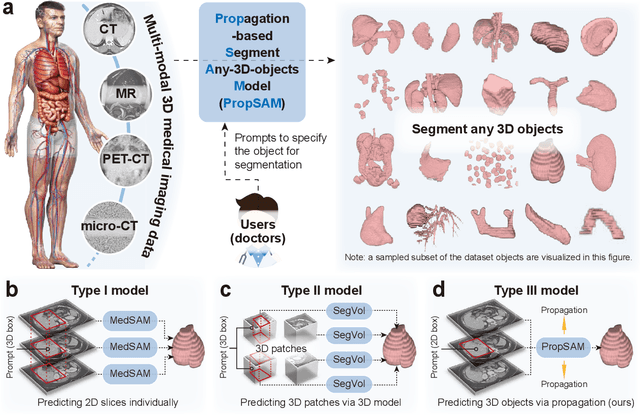
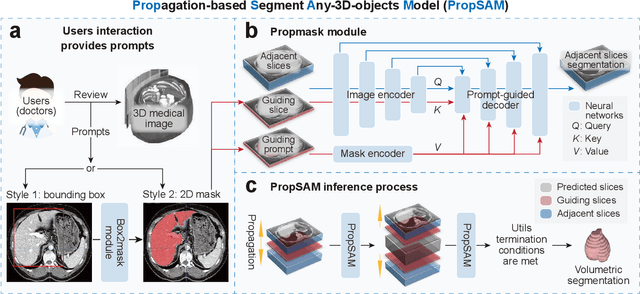
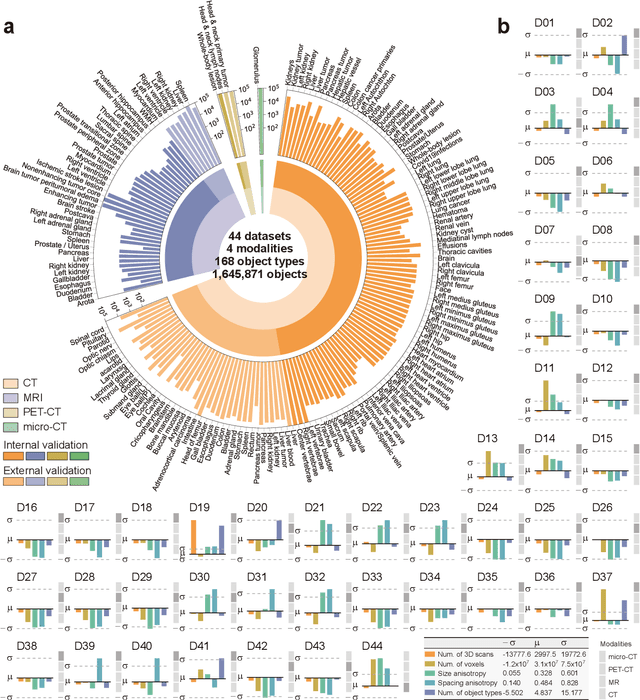
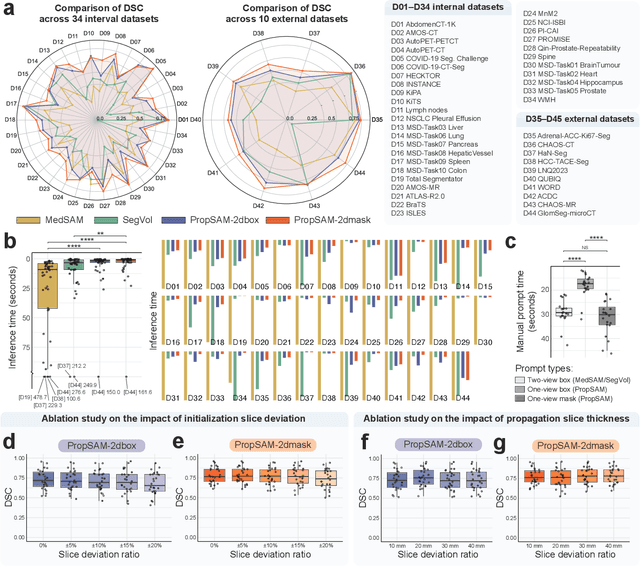
Abstract:Volumetric segmentation is crucial for medical imaging but is often constrained by labor-intensive manual annotations and the need for scenario-specific model training. Furthermore, existing general segmentation models are inefficient due to their design and inferential approaches. Addressing this clinical demand, we introduce PropSAM, a propagation-based segmentation model that optimizes the use of 3D medical structure information. PropSAM integrates a CNN-based UNet for intra-slice processing with a Transformer-based module for inter-slice propagation, focusing on structural and semantic continuities to enhance segmentation across various modalities. Distinctively, PropSAM operates on a one-view prompt, such as a 2D bounding box or sketch mask, unlike conventional models that require two-view prompts. It has demonstrated superior performance, significantly improving the Dice Similarity Coefficient (DSC) across 44 medical datasets and various imaging modalities, outperforming models like MedSAM and SegVol with an average DSC improvement of 18.1%. PropSAM also maintains stable predictions despite prompt deviations and varying propagation configurations, confirmed by one-way ANOVA tests with P>0.5985 and P>0.6131, respectively. Moreover, PropSAM's efficient architecture enables faster inference speeds (Wilcoxon rank-sum test, P<0.001) and reduces user interaction time by 37.8% compared to two-view prompt models. Its ability to handle irregular and complex objects with robust performance further demonstrates its potential in clinical settings, facilitating more automated and reliable medical imaging analyses with minimal retraining.
propnet: Propagating 2D Annotation to 3D Segmentation for Gastric Tumors on CT Scans
May 29, 2023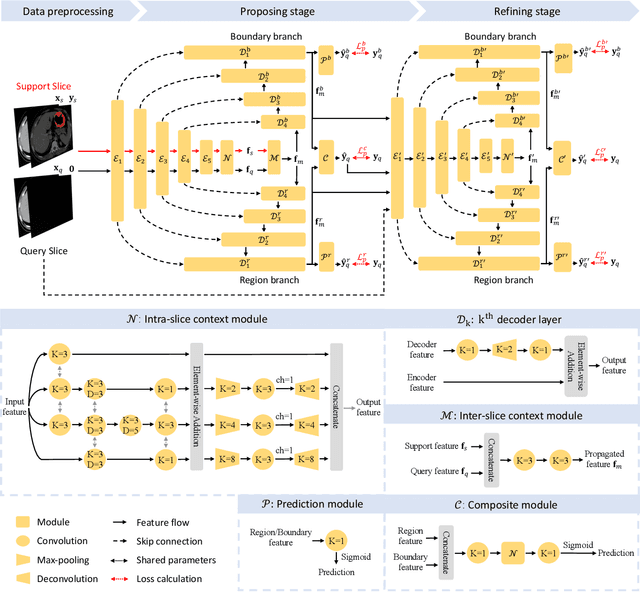
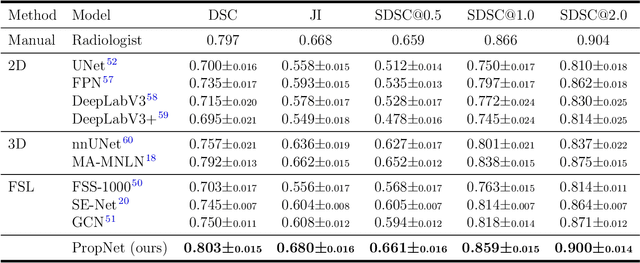


Abstract:**Background:** Accurate 3D CT scan segmentation of gastric tumors is pivotal for diagnosis and treatment. The challenges lie in the irregular shapes, blurred boundaries of tumors, and the inefficiency of existing methods. **Purpose:** We conducted a study to introduce a model, utilizing human-guided knowledge and unique modules, to address the challenges of 3D tumor segmentation. **Methods:** We developed the PropNet framework, propagating radiologists' knowledge from 2D annotations to the entire 3D space. This model consists of a proposing stage for coarse segmentation and a refining stage for improved segmentation, using two-way branches for enhanced performance and an up-down strategy for efficiency. **Results:** With 98 patient scans for training and 30 for validation, our method achieves a significant agreement with manual annotation (Dice of 0.803) and improves efficiency. The performance is comparable in different scenarios and with various radiologists' annotations (Dice between 0.785 and 0.803). Moreover, the model shows improved prognostic prediction performance (C-index of 0.620 vs. 0.576) on an independent validation set of 42 patients with advanced gastric cancer. **Conclusions:** Our model generates accurate tumor segmentation efficiently and stably, improving prognostic performance and reducing high-throughput image reading workload. This model can accelerate the quantitative analysis of gastric tumors and enhance downstream task performance.
Learning to Check Contract Inconsistencies
Dec 15, 2020



Abstract:Contract consistency is important in ensuring the legal validity of the contract. In many scenarios, a contract is written by filling the blanks in a precompiled form. Due to carelessness, two blanks that should be filled with the same (or different)content may be incorrectly filled with different (or same) content. This will result in the issue of contract inconsistencies, which may severely impair the legal validity of the contract. Traditional methods to address this issue mainly rely on manual contract review, which is labor-intensive and costly. In this work, we formulate a novel Contract Inconsistency Checking (CIC) problem, and design an end-to-end framework, called Pair-wise Blank Resolution (PBR), to solve the CIC problem with high accuracy. Our PBR model contains a novel BlankCoder to address the challenge of modeling meaningless blanks. BlankCoder adopts a two-stage attention mechanism that adequately associates a meaningless blank with its relevant descriptions while avoiding the incorporation of irrelevant context words. Experiments conducted on real-world datasets show the promising performance of our method with a balanced accuracy of 94.05% and an F1 score of 90.90% in the CIC problem.
 Add to Chrome
Add to Chrome Add to Firefox
Add to Firefox Add to Edge
Add to Edge